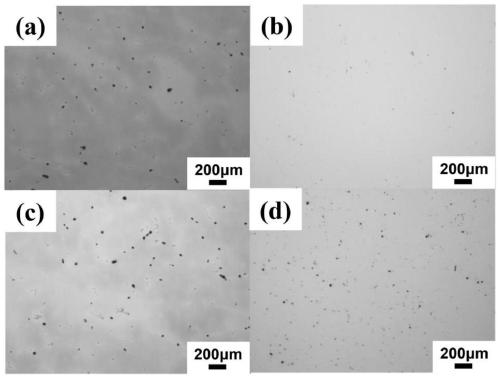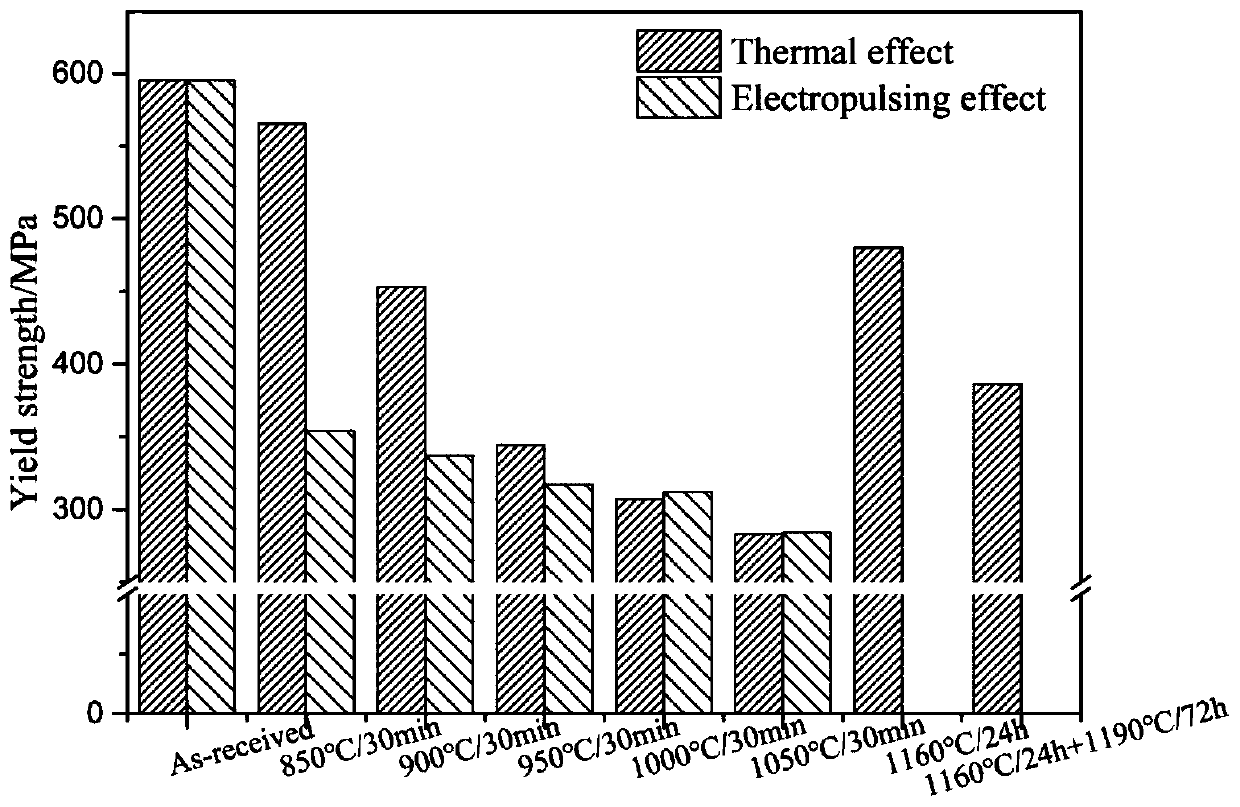Method for rapidly eliminating dendritic segregation in deformed high-temperature alloy ingot by pulse current
A technology of deforming superalloy and pulse current, applied in the field of dendrite segregation, can solve the problems of high heat treatment temperature, long treatment time, complicated process, etc., achieve low room temperature yield strength, realize plasticity, and accelerate the effect of diffusion rate
- Summary
- Abstract
- Description
- Claims
- Application Information
AI Technical Summary
Problems solved by technology
Method used
Image
Examples
Embodiment 1
[0031] In this embodiment, the pulse parameters are set to 30000Hz, 1.2V, 14.721A / mm 2 . Under this parameter, the temperature measured by the K-type thermocouple is 850°C. Continue to apply the pulse for 30min, then air cool to room temperature. Specific steps are as follows:
[0032] (1) Take a rectangular deformation area of 20×4×1.5mm 3 The first-stage homogenized heat-treated material, the surface is polished with 180 mesh, 600 mesh, 1000 mesh, 1500 mesh and 2000 mesh sandpaper in sequence until there are no visible defects to ensure good contact with the pulse electrode.
[0033](2) Pulse current external field treatment. Fix the superalloy polished in step (1) to both ends of the pulse power supply with copper fixtures. The pulse treatment was continued at room temperature for 30 minutes, and the surface temperature of the superalloy was 850 °C measured by a K-type thermocouple after applying a pulse current external field.
[0034] (3) Test the tensile strength...
Embodiment 2
[0038] In this embodiment, the pulse parameters are set to 30000Hz, 1.45V, 17.570A / mm 2 . Under this parameter, the temperature is measured by a K-type thermocouple, and the temperature is 950°C. Continue to apply the pulse for 30min, then air cool to room temperature.
[0039] (1) Take a rectangular deformation area of 20×4×1.5mm 3 The first-stage homogenized heat-treated material, the surface is polished with 180 mesh, 600 mesh, 1000 mesh, 1500 mesh and 2000 mesh sandpaper in sequence until there are no visible defects to ensure good contact with the pulse electrode.
[0040] (2) Pulse current external field treatment. Fix the superalloy polished in step (1) to both ends of the pulse power supply with copper fixtures. The pulse treatment was continued for 30 minutes at room temperature, and the surface temperature of the superalloy was 950 °C measured by a K-type thermocouple after applying a pulse current external field.
[0041] (3) Test the tensile strength at room...
Embodiment 3
[0045] In this embodiment, the pulse parameters are set to 30000Hz, 1.6V, 19.676A / mm 2 . Under this parameter, the temperature is measured by a K-type thermocouple, and the temperature is 1050°C. Continue to apply the pulse for 30min, then air cool to room temperature. Specific steps are as follows:
[0046] (1) Take 30×4×1.5mm 3 With rectangular deformation zone 20 x 4 x 1.5mm 3 The material in the first-stage homogenization heat treatment state, the surface is polished with 180 mesh, 600 mesh, 1000 mesh, 1500 mesh and 2000 mesh sandpaper in sequence until there are no visible defects to the naked eye to ensure good contact with the pulse electrode.
[0047] (2) Pulse current external field treatment. Fix the superalloy polished in step (1) to both ends of the pulse power supply with copper fixtures. The pulse treatment was continued for 30 minutes at room temperature, and the surface temperature of the superalloy was 1050 °C measured by a K-type thermocouple after appl...
PUM
| Property | Measurement | Unit |
|---|---|---|
| Yield strength | aaaaa | aaaaa |
Abstract
Description
Claims
Application Information
 Login to View More
Login to View More - R&D
- Intellectual Property
- Life Sciences
- Materials
- Tech Scout
- Unparalleled Data Quality
- Higher Quality Content
- 60% Fewer Hallucinations
Browse by: Latest US Patents, China's latest patents, Technical Efficacy Thesaurus, Application Domain, Technology Topic, Popular Technical Reports.
© 2025 PatSnap. All rights reserved.Legal|Privacy policy|Modern Slavery Act Transparency Statement|Sitemap|About US| Contact US: help@patsnap.com


